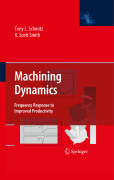
Machining dynamics: frequency response to improved productivity
Schmitz, Tony L.
Smith, Kevin S.
‘Machining dynamics: From frequency response to improved productivity’ will train engineers and students in the practical application of machining dynamics, with a particular focus on milling. The book is arranged such that the stepsrequired to improve machining productivity through chatter avoidance and reduced surface location error (forced vibrations resulting in part geometric errors) are clearly evident. The following topics are covered in detail: modal analysis, including experimental methods, to obtain the tool point frequency response function; descriptions of turning and milling, including force modeling, time domain simulation, stability lobe diagram algorithms, and surface location error calculation for milling; and receptance coupling methods for tool point frequency response prediction, including beam theory. Numerical examples areincluded, as well as the MATLAB code used to develop the figures. Provides a clear description of predictive algorithms for process performance Provides the necessary information in a manner that enables rapid implementation Offers acomprehensive source of the fundamentals of machining dynamics that leads to reduced reliance on handbooks and rules of thumb Includes functional MATLAB code for process predictions INDICE: Introduction.- Modal analysis.- Turning dynamics.- Milling dynamics.- Surface location error in milling.- Special topics in milling.- Tool pointdynamics prediction.
- ISBN: 978-0-387-09644-5
- Editorial: Springer
- Encuadernacion: Cartoné
- Páginas: 303
- Fecha Publicación: 01/11/2008
- Nº Volúmenes: 1
- Idioma: Inglés
